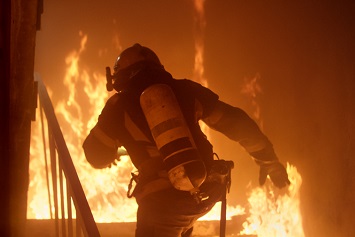The National Institute for Occupational Safety and Health signed a memorandum of understanding (MOU) with the National Fire Protection Association (NFPA) and NFPA’s research affiliate, the Fire Protection Research Foundation, to cooperate on issues involving emergency responder personal protective clothing and equipment (PPE), including the development of standards concerning first responder safety, deployment, operations, and the protection of emergency personnel.
NIOSH, the NFPA, and the Research Foundation agreed to cooperate on the following tasks:
- Working together on technical information and standards concerning performance, testing, validation, use, care, and maintenance of responder PPE, as well as safety issues concerning deployment and operations;
- Sharing relevant information concerning testing data, research studies, program findings, and standards development to enhance each organization’s efforts and overall responder effectiveness;
- Providing insights related to firefighter exposure and acute and chronic injuries, illnesses, and diseases such as cancers, respiratory disease, heart disease, and musculoskeletal injuries;
- Exchanging recommendations and lessons learned from firefighter fatality investigations to advance the development, adoption, and revision of standards;
- Developing death and injury prevention guidance and ways to promote best practices to responder organizations and, when appropriate, incorporating the information into NIOSH regulations and compliance;
- Working to ensure NIOSH regulations and NFPA consensus standards are adopted by the Department of Homeland Security (DHS) and the InterAgency Board (IAB) for Equipment Standardization and Interoperability;
- Incorporating NFPA technical expertise and guidance for long-term technology deployment related to emergency responders and their organizations;
- Supporting the NIOSH-National Firefighter Registry (NFR) efforts to expand sources of data for individual firefighter exposure; and
- Participating in peer reviews for projects and resources related to the above topics.
The NFR will be a large database of health and occupational information on firefighters that would be used to analyze and track cancers and identify occupational risk factors for cancer to help protect emergency responders from occupational illnesses.
“The NFPA is a critical partner in NIOSH’s efforts to protect emergency responders from hazards encountered in the line of duty,” NIOSH Director John Howard, MD, said in a statement.
The new 10-year MOU continues NIOSH’s participation in NFPA Technical Committees that work on responder organization operations, deployment, training, and safety, according to the institute.
There are, on average, 67 on-duty firefighter deaths each year, according to NFPA data. NIOSH conducts independent investigations of firefighter line-of-duty deaths through its Fire Fighter Fatality Investigation and Prevention Program (FFFIPP). The FFFIPP issues reports on firefighter fatalities, along with recommendations for preventing deaths and injuries.
For example, following an investigation of a career fire lieutenant who died while fighting a row house fire, NIOSH issued a fact sheet and poster outlining tactics to ensure the safety of firefighters responding to row house fires.
The NFPA is a standards-setting organization whose consensus standards include the National Electrical Code (NFPA 70), Life Safety Code (NFPA 101), and NFPA 1600 Standard on Disaster/Emergency Management and Business Continuity/Continuity of Operations Programs, as well as standards for fire alarms, fire extinguishers, and fire suppression systems. It also provides education, outreach, and training.
Its research arm, the Fire Protection Research Foundation, facilitates domestic and international research into issues that include electrical safety, fire detection and signaling, fire suppression, hazardous materials, materials storage, and PPE for firefighters.

